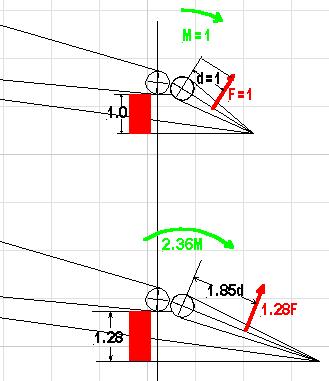|
|
 Because of Kolb List discussion, I decided to check to see what effect the aileron and roll control mod's had on reducing roll stick pressure. Above is the wing set up for cruise. The ailerons are scaled to reflect fifteen and nine inch chord ailerons. The maximum roll axis control for the FireFly with the nine inch chord aileron was set at 20 degrees. A chord line was drawn from the nose through the tip of the nine inch chord and extended. The fifteen inch chord aileron (green) was rotated until the tip touched the extended chord line and resulted in a deflection of 10.5 degrees.
Because of Kolb List discussion, I decided to check to see what effect the aileron and roll control mod's had on reducing roll stick pressure. Above is the wing set up for cruise. The ailerons are scaled to reflect fifteen and nine inch chord ailerons. The maximum roll axis control for the FireFly with the nine inch chord aileron was set at 20 degrees. A chord line was drawn from the nose through the tip of the nine inch chord and extended. The fifteen inch chord aileron (green) was rotated until the tip touched the extended chord line and resulted in a deflection of 10.5 degrees.
It is assumed that since both deflected ailerons share the same chord line that they will produce an equal rolling moment or lift at the same air speed. |
 I decided to use the modified aileron as the standard and to calculate the difference based on the original aileron. And so the flow area (red) that impacts the bottom side of the aileron, and the resultant force vector located at mid chord and the perpendicular distance from the hinge point to the force vector are all assumed to be one. The hinge point was assumed at the center of the aileron leading edge tube. And the resulting resistive moment (green) that the bell crank must support calculates out to be one.
I decided to use the modified aileron as the standard and to calculate the difference based on the original aileron. And so the flow area (red) that impacts the bottom side of the aileron, and the resultant force vector located at mid chord and the perpendicular distance from the hinge point to the force vector are all assumed to be one. The hinge point was assumed at the center of the aileron leading edge tube. And the resulting resistive moment (green) that the bell crank must support calculates out to be one.
From this base standard and assuming the equal ias, one can compute the differences. The full sized aileron will see greater dynamic loading. And the aileron center of pressure (chord mid point) is a greater distance from the point of rotation. Multiplying these two together gives the new resistive bell crank moment. This indicates that the fifteen inch aileron requires 2.36 times bell crank moment than what was required for the nine inch aileron. |
 When one deflects the aileron down, the dynamic pressure on the aileron will try to push the trailing edge of the wing upward. This twisting moment must be transferred through the ribs to the main spar. The next step is to determine the difference in spar moment or twist. This is done by finding the perpendicular distance between the center of the spar to the force line of action.
When one deflects the aileron down, the dynamic pressure on the aileron will try to push the trailing edge of the wing upward. This twisting moment must be transferred through the ribs to the main spar. The next step is to determine the difference in spar moment or twist. This is done by finding the perpendicular distance between the center of the spar to the force line of action.
Again, the nine inch chord aileron is used as the base standard. The fifteen inch aileron subjects the main spar to 1.34 times the moment or twist than the nine inch chord aileron. |
 Some may wonder if by changing to shorter chord ailerons that you may run out of stick travel. When I measured the original FireFly stick travel in roll, I discovered that at maximum travel the ailerons deflected 24 degrees down. To limit the maximum movement to 20 degrees down, I was able to move the aileron push pull rod end holes in the "Tee" bar inward by 13/16s of an inch. This changed the lever arm length from 3.688 to 2.875 inches.
Some may wonder if by changing to shorter chord ailerons that you may run out of stick travel. When I measured the original FireFly stick travel in roll, I discovered that at maximum travel the ailerons deflected 24 degrees down. To limit the maximum movement to 20 degrees down, I was able to move the aileron push pull rod end holes in the "Tee" bar inward by 13/16s of an inch. This changed the lever arm length from 3.688 to 2.875 inches.
With this change the stick force mechanical advantage in roll improves by a factor of 1.28. |